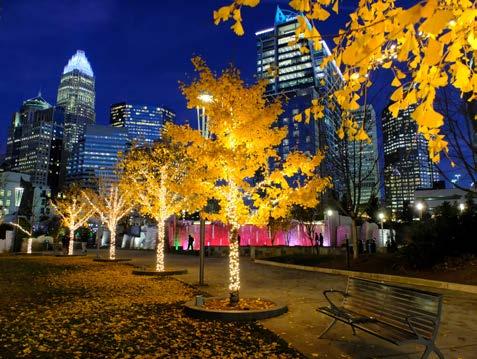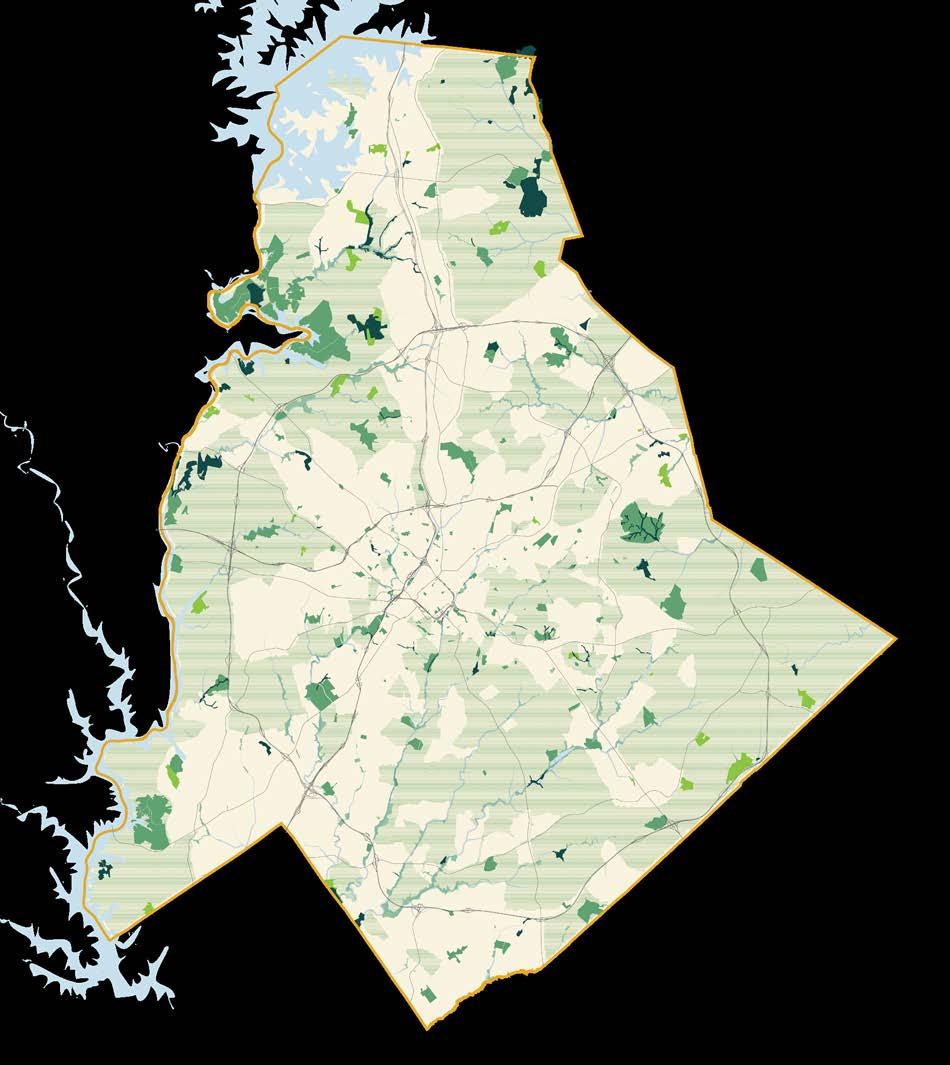
8 minute read
Goal #5 Stewardship
Protect and adapt the resilience of natural areas for future generations in Mecklenburg County.
5.1 Expand efforts to actively manage natural spaces to preserve ecosystems and provide habitat for native flora and fauna.
Advertisement
Mecklenburg County contains a myriad of natural resources, including temperate forests, wetlands, an extensive stream network, and a biodiverse animal population. Some of the most valuable natural resources in the County exist in riparian buffers, or areas along streams and waterways. These buffers are critical in supporting wildlife habitat and a healthy stream network. The rolling topography of the Appalachian Plateau region divides the County’s 3,000 miles of streams and creeks into three major watersheds: the Yadkin, Upper Catawba and Lower Catawba.
The Catawba-Wateree Watershed provides drinking water to 2 million, and yet is one of the country’s most endangered waterways. Plants and other vegetation within the riparian buffers help filter out pollutants and sediment and prevent them from entering the region’s water supply. Proper active management is essential to support this watershed. Active habitat and forest management can protect air quality, drinking water, and habitats for humans and animals alike.
5.1 Key Actions
Actively manage natural species:
• Survey and mark boundaries of existing
County-owned properties to gather information and properly care for them.
• Evaluate new properties for natural and ecological value and incorporate into the County inventory.
• Expand vegetation research and preservation efforts like those ongoing at Reedy Creek and Stevens Creek
Nature Preserves. Mitigate invasive species through monitoring, removal, and controlled burns to encourage native tree growth.
• Monitor animal populations for disease or population changes.
Conservation Land
Tree Canopy (Greater than 50%)
Park Property (Developed)
Park Property (Greenway)
Parkland Reserve
Conservation Land (CLC+ Catawba)
Waterway
3.4 Current land undergoing conservation efforts.
5.2 Expand, restore, and permanently protect County-owned conservation areas, including greenways and waterway buffers.
The County protects over 7,700 acres of nature preserves. These preserves include important ecosystems like native plant communities and stream corridors. Latta Nature Preserve, Reedy Creek Nature Preserve, and McDowell Nature Preserve are the three largest preserves in the county, and each provides nature education to the community as well as conservation. In 2019 alone, almost 1.2 million people visited the county’s nature preserves to learn about the natural systems right outside their backyards. Protecting the County’s streams and creeks is also critical to the long-term health of the community. The greenway system currently spans more than 4,200 acres. Almost all (99%) of greenway land intersects with a creek or stream in at least one location. Similarly, 74% of County parks are located along a stream or lake. Thus, protecting these amenities also means protecting natural waterways. In the mid-2000s, the County had already executed a plan to buy and protect over 3,000 acres of land along the shoreline of Mountain Island Lake, the primary drinking water supply to almost all residents of Mecklenburg County. Although the overall acreage of preserved lands is important, the ecological impact of these lands is diminished if they are scattered throughout the County. As development surges in the County, it is increasingly important to create buffers and to realize the full ecological and community benefits.


3.5 Sections of current conserved lands show how human, ecological, and transportation needs exist can symbiotically.
5.2 Key Actions
Expand and Protect Conservation Areas:
• Build land acquisition targets for preservation into the Capital
Improvement Plan.
• Acquire and actively manage riparian buffers and native habitat areas.
• Prioritize acquisition adjacent to existing conservation lands that connect and expand habitat corridors and riparian buffers.
5.3 Design and manage facilities to balance recreational use with environmental protection.
Mecklenburg County’s land resources serve a dual purpose; they are often critical both for natural resource benefits and for human use. This is particularly true for greenway trails, which have a special relationship with stream corridors. Streams are beautiful and valuable natural resources. Due to their flood potential, they are often deemed only suitable for passive recreation uses and not desirable for development. They also form linear corridors perfect for long stretches of trails. This is the ideal relationship: if greenway trails are carefully planned, they can have minimal impact on the stream corridor while allowing users to interact closely with the stream and the aquatic ecosystem. Greenways provide land for recreation while simultaneously adding significant flood plain protection. Parks can also vary greatly in their environmental impact, depending on siting, design, and use decisions. Some parks may be almost completely preserved with low impact amenities like natural trails, providing recreation opportunities that coexist with nature. Other parks with larger amenities may have more of an impact. Sports fields in particular, often disturb the natural environment because of their large size and grading, which requires disruptive earthwork and creates stormwater management issues. These manicured areas may also be very resource intensive over time, requiring consistent watering, mowing, and fertilization. The latter, which the County currently participates in an plans to continue, can contribute to offsite water quality impacts. However, with careful planning, the environmental impacts of new and existing parks, bicycle routes, and trails can be reduced, if not entirely mitigated.
5.3 Key Actions
Balance land allocated for recreation and protection:
• Implement flexible recreation solutions that encourage multiple uses.
Create standards for facility design and management that align with the County’s Environmental Leadership Plan.
Build environmental education into facility design and greenway trails.
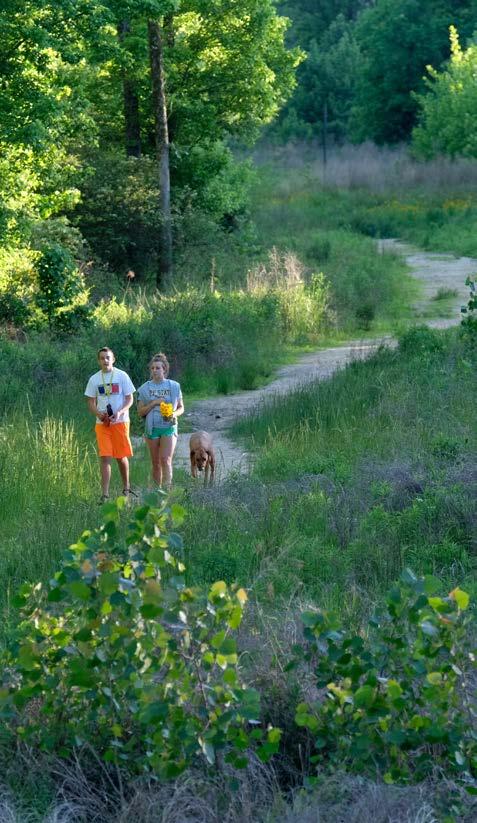
3.6 Managing invasive and native plant populations in places like McAlpine Greenway have a positive environmental impact and provide natural places to explore.
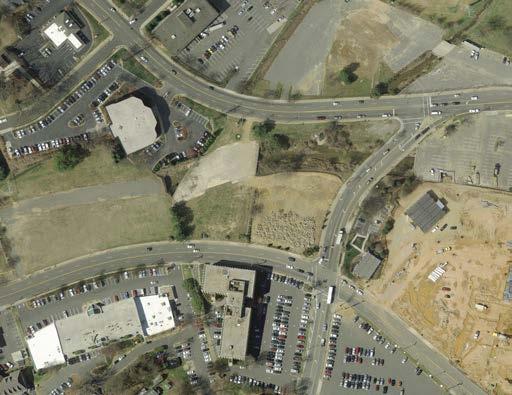
Image Kucera Intl./Mecklenburg County Image Kucera Intl./Mecklenburg County N➤
Image Kucera Intl./Mecklenburg County
3.7 Little Sugar Creek near Uptown used to be a
“capped” waterway, flowing through a pipe.
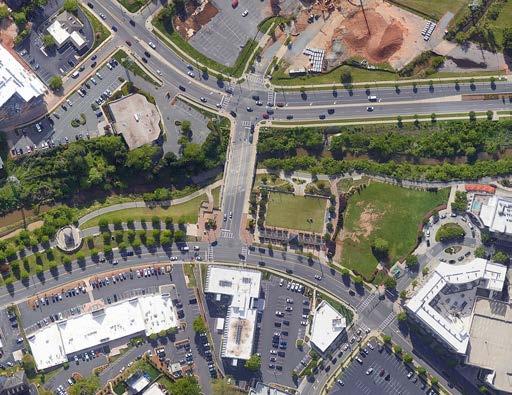
N➤
3.8 Unearthing the stream provided space for the greenway trail and reconnected the creek to its watershed.
5.4 Increase productive landscapes in parks to enhance stormwater infrastructure, support pollinator species, and beautify surrounding neighborhoods.
Natural systems and ecosystem function exist everywhere in Mecklenburg County, from designated nature preserves to urban patches. Crafting landscapes to reduce runoff provides many benefits to parks and the people that use them. This “green infrastructure” can include rain gardens, vegetated swales, stream restoration, rainwater harvesting, green roofs, protected floodplains, and more. These systems provide great ecological benefits - and when they are properly designed they can offer considerable recreational and financial benefits as well.
For example, parks that have suitable soils and topography can decrease municipal spending on stormwater management by utilizing natural stormwater management techniques such as rain gardens or vegetated swales. In Philadelphia, the Trust for Public Land estimates that the City saves about $6 million a year in stormwater costs due to parks. These methods can improve drainage and water quality in the parks, and in some cases can even filter and absorb runoff from surrounding areas. However, these benefits are easily negated if the system is not properly designed or appropriate maintenance is not performed. While the exact costs of the impact of stormwater runoff in Mecklenburg County are unknown, the siting of over three-quarters of the County’s open space system along waterways makes it a valuable stormwater resource.
Additionally, green infrastructure is often highly compatible with recreation value. Other stormwater management techniques like vegetated wetlands can provide beautiful walking environments with space to fish or birdwatch. Native vegetation can be used to support animal habitats, absorb stormwater, improve air quality, and enhance park aesthetics.
5.4 Key Actions
Collaborate with Charlotte-Mecklenburg Stormwater Services on open space improvements and green infrastructure projects.
Identify the stormwater benefits of the County’s open space system to support for future open space expansion.
5.5 Leverage County-owned land and partnership opportunities to expand tree canopy and close gaps.
In general, Charlotte is known as a verdant city with beautiful tree-lined streets. This lush canopy has come to be a defining feature of the area. However, from 1985 to 2008, Mecklenburg County lost 33% of its tree canopy. Charlotte fared even worse, losing 49% of its tree canopy and 5% of its open space during the same period. Urban trees are not only beautiful; they are an important natural resource that we are in danger of losing. In the 2017 Urban Forest Master Plan, Charlotte set goals to expand tree canopy coverage and continue tree planting strategies. Charlotte 2040 makes increasing the tree canopy an imperative action of its plan through the Tree Canopy Action Plan, which will add detail to the 50 by 50 goal by setting specific tree coverage goals for different place types. Continuing to plant trees on county-owned land while enhancing efforts like the City of Charlotte’s Tree Canopy Action Plan and partners will be important to reach these goals. It is also recommended that Mecklenburg Park & Rec continue to advocate for ordinances encourage canopy retention. Meck Playbook strives to support these canopy rehabilitation plans throughout the County. Mecklenburg Park & Rec can specifically contribute through land acquisitions or by supporting municipalities to impose development impact fees. These fees would prioritize existing tree preservation, tree succession planning on County-owned land, and planting strategies that value shade. Mecklenburg Park & Rec can also collaborate with other departments to support tree planting strategies on streets, urban trails, and potential partner sites that directly connect to their facilities or programs.
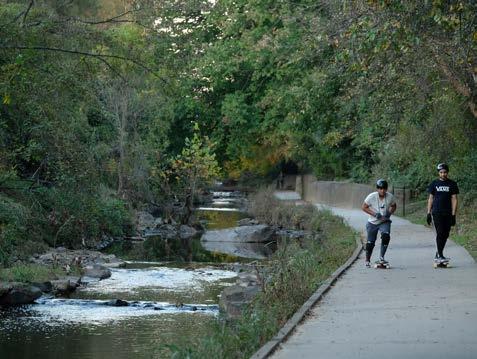
3.9 Recent investments in Greenway trails include reforestation efforts to bring back the County’s beloved tree canopy. 3.10 Trees at Romare Bearden Park provide shade during the summer months and a holiday spectacle during the winter months.
